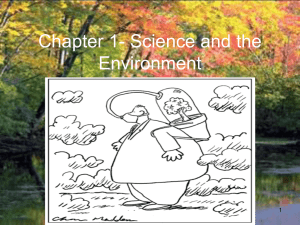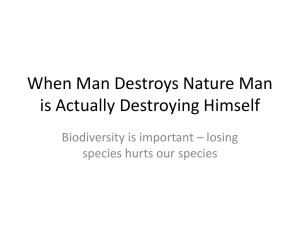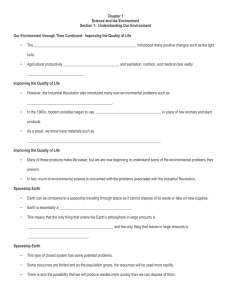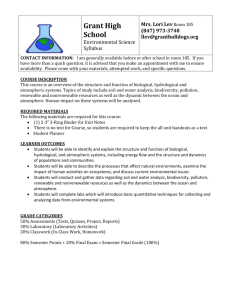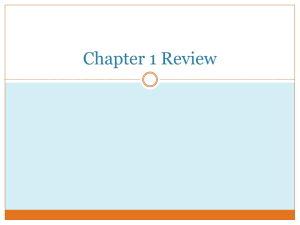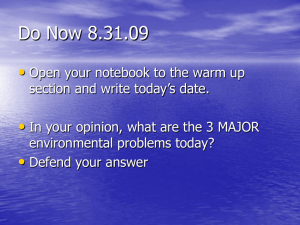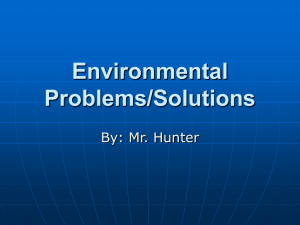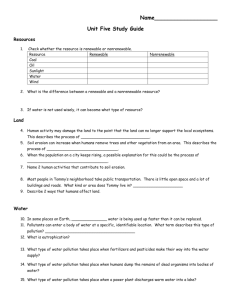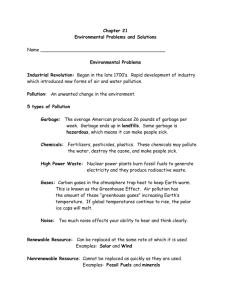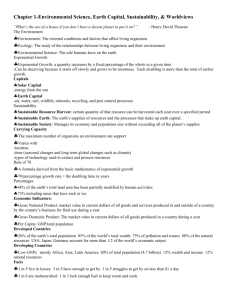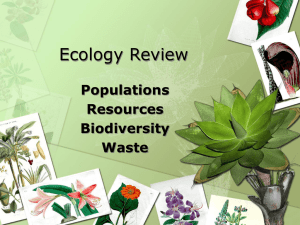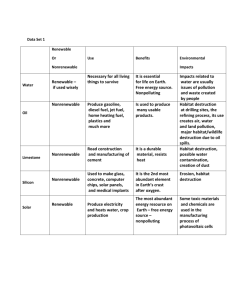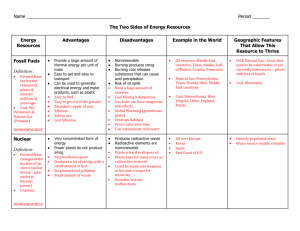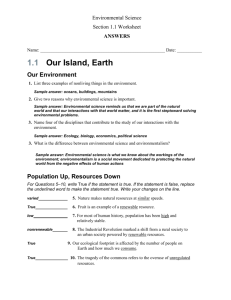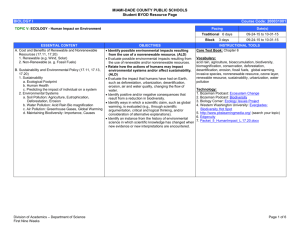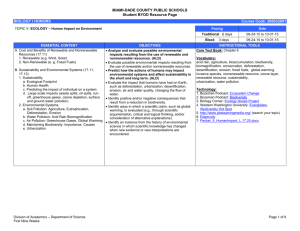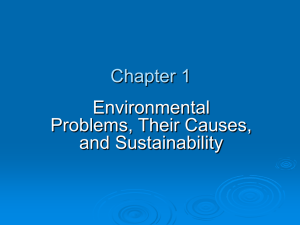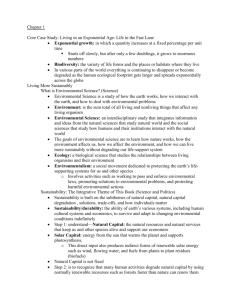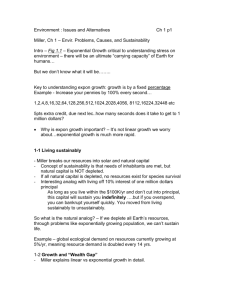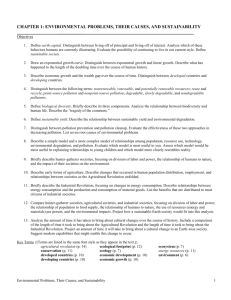Section 1.3 student notes CD
advertisement
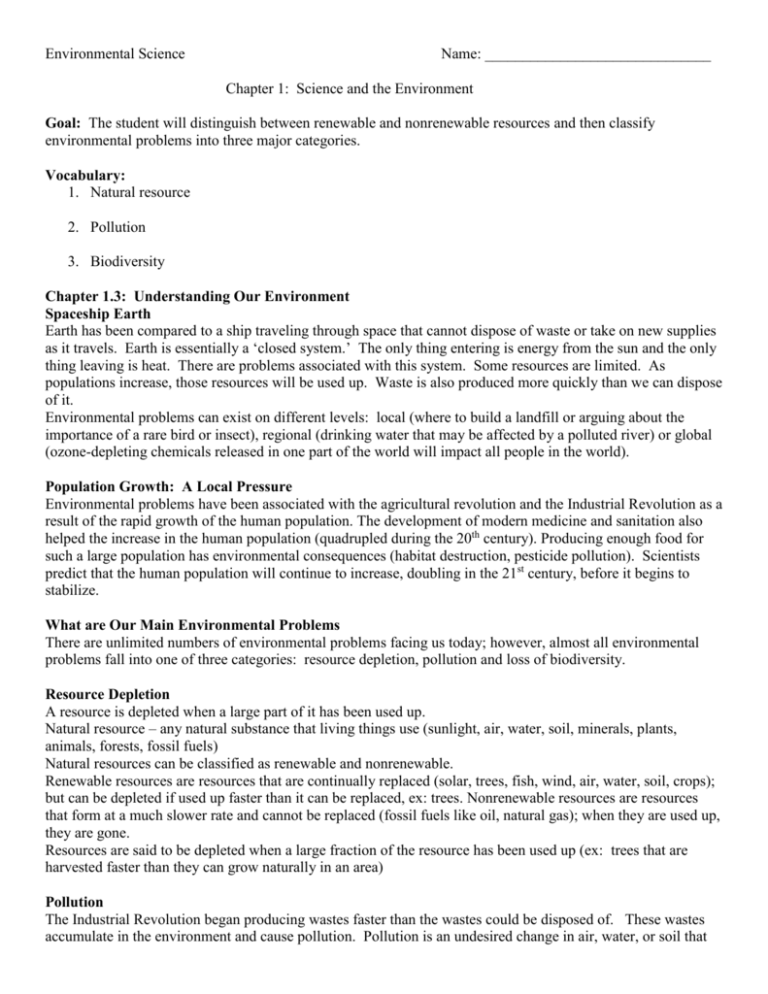
Environmental Science Name: ______________________________ Chapter 1: Science and the Environment Goal: The student will distinguish between renewable and nonrenewable resources and then classify environmental problems into three major categories. Vocabulary: 1. Natural resource 2. Pollution 3. Biodiversity Chapter 1.3: Understanding Our Environment Spaceship Earth Earth has been compared to a ship traveling through space that cannot dispose of waste or take on new supplies as it travels. Earth is essentially a ‘closed system.’ The only thing entering is energy from the sun and the only thing leaving is heat. There are problems associated with this system. Some resources are limited. As populations increase, those resources will be used up. Waste is also produced more quickly than we can dispose of it. Environmental problems can exist on different levels: local (where to build a landfill or arguing about the importance of a rare bird or insect), regional (drinking water that may be affected by a polluted river) or global (ozone-depleting chemicals released in one part of the world will impact all people in the world). Population Growth: A Local Pressure Environmental problems have been associated with the agricultural revolution and the Industrial Revolution as a result of the rapid growth of the human population. The development of modern medicine and sanitation also helped the increase in the human population (quadrupled during the 20th century). Producing enough food for such a large population has environmental consequences (habitat destruction, pesticide pollution). Scientists predict that the human population will continue to increase, doubling in the 21st century, before it begins to stabilize. What are Our Main Environmental Problems There are unlimited numbers of environmental problems facing us today; however, almost all environmental problems fall into one of three categories: resource depletion, pollution and loss of biodiversity. Resource Depletion A resource is depleted when a large part of it has been used up. Natural resource – any natural substance that living things use (sunlight, air, water, soil, minerals, plants, animals, forests, fossil fuels) Natural resources can be classified as renewable and nonrenewable. Renewable resources are resources that are continually replaced (solar, trees, fish, wind, air, water, soil, crops); but can be depleted if used up faster than it can be replaced, ex: trees. Nonrenewable resources are resources that form at a much slower rate and cannot be replaced (fossil fuels like oil, natural gas); when they are used up, they are gone. Resources are said to be depleted when a large fraction of the resource has been used up (ex: trees that are harvested faster than they can grow naturally in an area) Pollution The Industrial Revolution began producing wastes faster than the wastes could be disposed of. These wastes accumulate in the environment and cause pollution. Pollution is an undesired change in air, water, or soil that adversely affects the health, survival or activities of humans or other organisms. Most pollution is a result of human activities. Two main types of pollutants: biodegradable (can be broken down by natural processes) pollutants and nonbiodegradable (cannot be broken down by natural processes) pollutants. Biodegradable pollutant examples would include human sewage or stacks of newspapers. These items present a problem when they accumulate faster than they can be broken down. Non-biodegradable pollutant examples would be mercury, lead and some plastics because they do not break down easily. Loss of Biodiversity Biodiversity refers to the number and variety of species that live in an area. Only a fraction of the hundreds of millions of species are alive today. All the others are now extinct. Extinction is a natural process, but during the course of history, Earth has experienced mass extinctions (250 million years ago, as much as 95% of all species became extinct). Why should we be concerned with extinction of species? We depend on other organisms for food, for the oxygen we breathe and for many other things. When a species becomes extinct, it is gone forever. We have limited information on the current rate of extinction among the species alive today in comparison to organisms in our past. Scientists believe that all species have potential economic, ecological, scientific, aesthetic and recreational value. So, they believe it is in our best interest to preserve all organisms. Lesson Reflection: Complete the handout on environmental problems. List some of the problems at each of the levels. Then, use your notes to give details of each of the environmental problems. Assessment: 1. How do scientists relate Earth to a spaceship? Explain. 2. The growth of the human population has been a result of the agricultural revolution and the Industrial Revolution. How has this growth impacted the environment? Lesson Extension (Technology/Application/Connection to Real World): What is the connection between natural resources and your clothes, the contents of your backpack, or some of the common objects you find in the classroom? As a group, make a list of the things you found and then determine if they are renewable or nonrenewable? Object Renewable Nonrenewable

